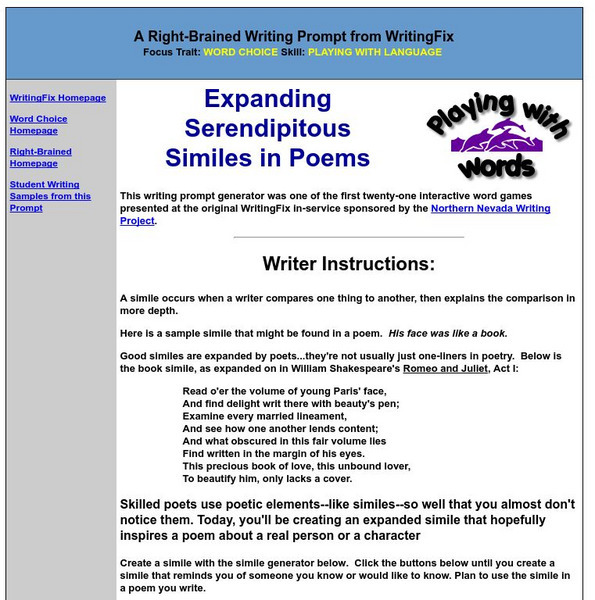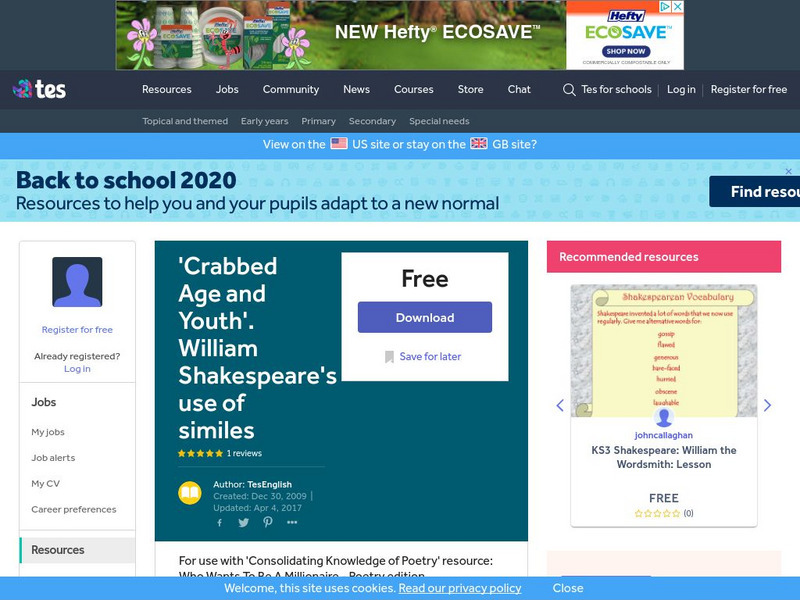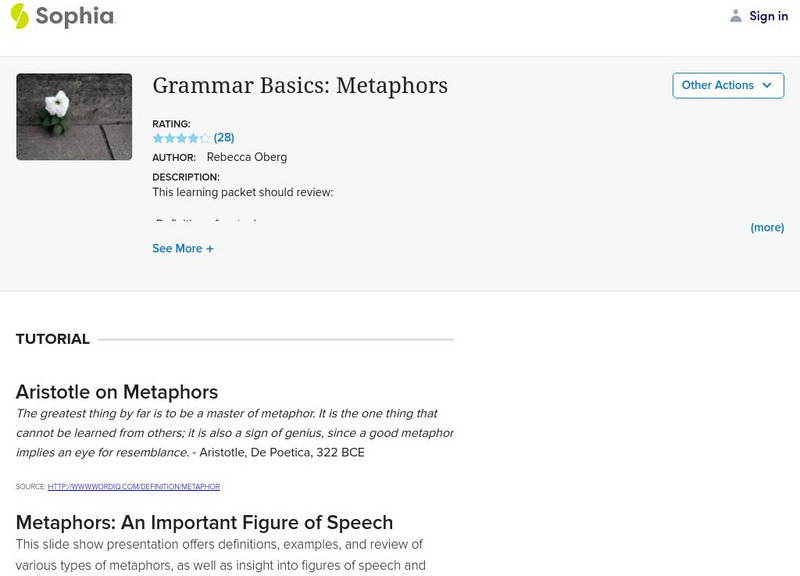Hi, what do you want to do?
Curated OER
Metaphors
In this metaphor worksheet, students make a "word card" with the word metaphor for their vocabulary bank, then determine whether statement from The Dragonslayer are similes or metaphors,
Curated OER
Dinosaur Alliterations
In this alliteration learning exercise, students review the definition and an example for alliterations. Students then write their own alliterations about dinosaurs and illustrate one of their examples in the box.
Curated OER
Fifth Grade Literature: January
Fifth graders examine and analyze various poems by Edward Hersey Richards, Robert Frost, and Emily Dickinson. They explore similes, and write journal entry responses.
Curated OER
Black Bayou Lake Short Story
Tenth graders use Microsoft Word to create an original short story. The setting must be Black Bayou Lake National Wildlife Refuge. The characters must be animals found at Black Bayou Lake National Wildlife Refuge. The story must contain...
Curated OER
New York State Testing Program English Language Arts Book 1--Grade 7 (2006)
In this New York State Testing Program English Language Arts worksheet, students read several passages and two poems and answer reading comprehension questions. Students then write an essay response to one of the passages.
Curated OER
A Magic Flower of Wishes
Students discuss which values are most important to them and their families. They read poetry and fairy tales to find a story that has the same value they find most important. They create a presentation and share it with the class.
Curated OER
Paradox Worlds
Students view and analyze "Still Life," by Cornelis de Heem. They answer discussion questions about the painting, write similes, discuss symbolism, create a still life sketch, and create a paint box poem.
Curated OER
Figurative and literal language through the study of Shakespeare
Sixth graders explore figurative and literal language. They study literary devices through short pieces of Shakespeare's work. Then investigate Shakespeare's works and life.
Curated OER
Inspire the Imagination with a Poet Study of Shel Silverstein
Captivating prose opens wondrous doors to critical thinking and language development.
Gwinnett County Public Schools
Analysis of the Tuck Everlasting and The Birchbark House Text Exemplars
Looking to introduce some text-based questions into your ELA lessons? Practice the kinds of skills the Common Core demands with the seven text-based questions and the essay prompt provided here. Designed to be a three-day lesson, day one...
Curated OER
Simile and Metaphor Lesson Ideas
Teaching students about literary devices, such as simile and metaphor, can be a year long experience.
Curated OER
Which Way To Go?
Students prepare for and respond to literature selections. This package of lessons includes nine lessons from the American Literature series, each covering a different reading selection about a man making a key life decision. Pre-reading...
Curated OER
VH1 Driven: Kanye West, Lesson 2
Students compose an original rap. They discuss the career and music of Kanye West, discuss their pre-writing worksheet, and write an original rap using a Final Draft Worksheet.
ReadWriteThink
Read Write Think: Lonely as a Cloud: Using Poetry to Understand Similes
Students identify similes in poetry and gain experience in using similes as a poetic device in their own work.
Writing Fix
Writing Fix: Expanding Serendipitous Similes in Poems
An explanation of simile and its role in poetry followed by a simile maker. Press the buttons to create a simile and then write a poem that expands that simile.
National Endowment for the Humanities
Neh: Edsit Ement: Recognizing Similes: Fast as a Whip
This lesson is designed to help students review what they have learned in earlier classes and to begin to engage with similes on a deeper and more abstract level. Students will define similes and identify examples; read and analyze the...
TES Global
Tes: 'Crabbed Age and Youth'. William Shakespeare's Use of Similes
[Free Registration/Login Required] This learning module contains a PowerPoint game that reviews literary and figurative elements that are present in poetry. Students will also analyze the William Shakespeare's poem, "Crabbed Age of...
Read Works
Read Works: 4th Grade Lesson: Similes and Metaphors
[Free Registration/Login Required] A lesson in which young scholars use the book Poetry for Young People: Langston Hughes edited by David Roessel and Arnold Rampersad to learn to identify and understand the use of simile and metaphor in...
Read Works
Read Works: 3rd Grade Lesson: Poetry
[Free Registration/Login Required] A lesson in which students use two provided poems to learn to identify and understand the use of similes and metaphors in poetry. Lesson includes direct teaching, guided practice, and independent...
Writing Fix
Writing Fix: How to Make Poetry
Students learn how to write poetry through ten Writing Workshop mini-lessons. Students complete the graphic organizers provided while learning to notice details, write similes and metaphors, and create patterns in their writing.
ReadWriteThink
Read Write Think: Wartime Poetry Working With Similes
Contains plans for four lessons that use photos and depictions of World War II to inspire similes to use in poems. In addition to objectives and standards, this instructional plan contains links to sites used in the lessons as well as...
British Library
British Library: 'Goblin Market' by Christina Rossetti
In 'Goblin Market', Rossetti employs imagery to explore Victorian debates around sin and temptation. Students will explore these techniques and apply them to their own work.
Love To Know Media
Your Dictionary: Literary Terms Lesson Plan
This is a lesson plan for teaching the seven literary terms used in poetry: simile, metaphor, alliteration, imagery, hyperbole, personification, and onomatopoeia.
Sophia Learning
Sophia: Grammar Basics: Metaphors
Learn about similes and metaphors through this multimedia presentation. First view a slide show describing different types of metaphors as well as a simile. Then watch a video [3:13] showing similes and metaphors used in popular songs. A...




























